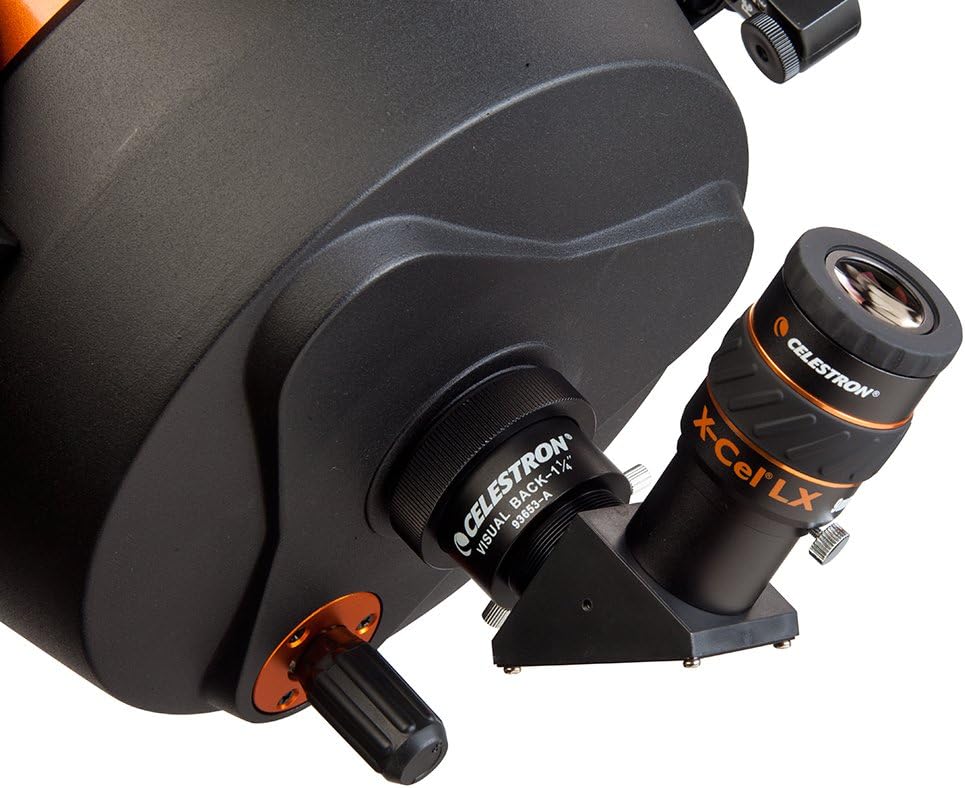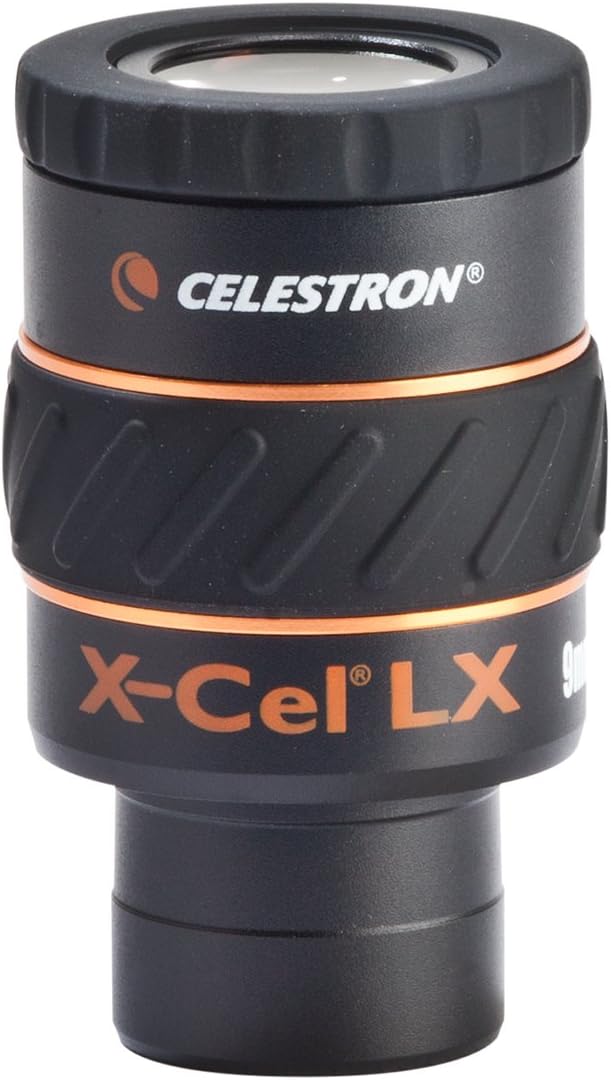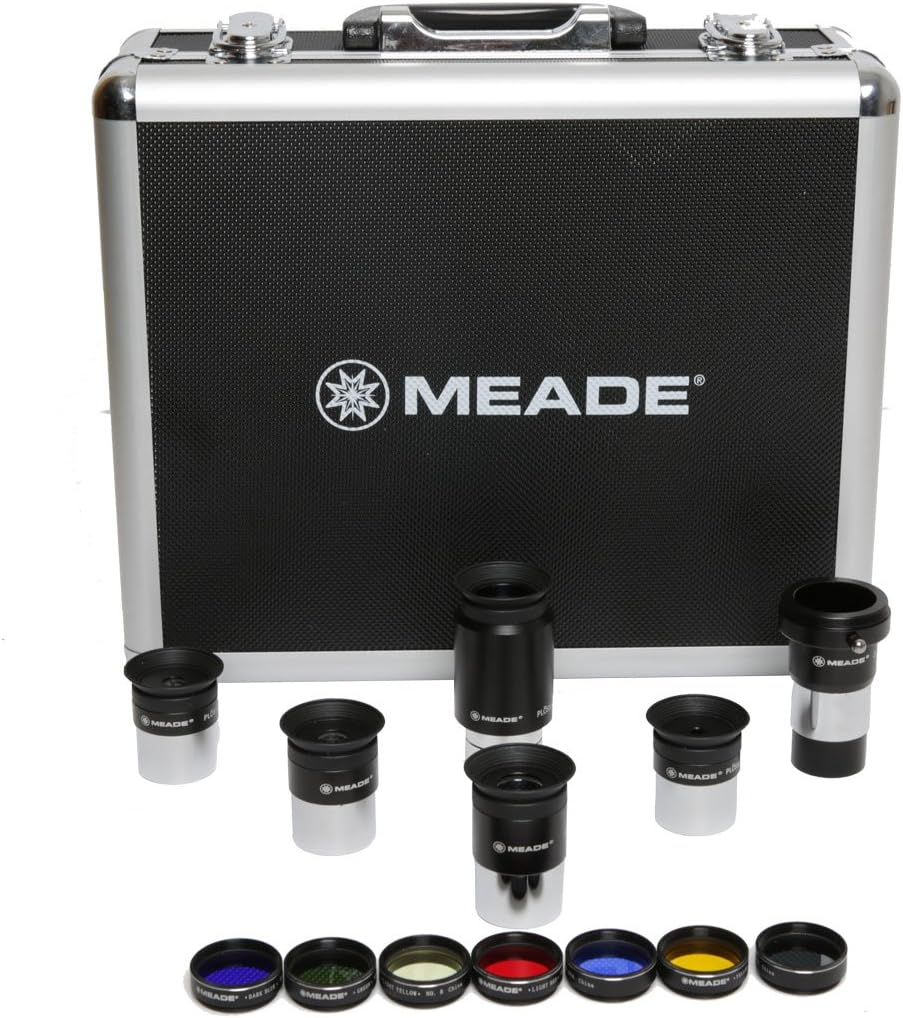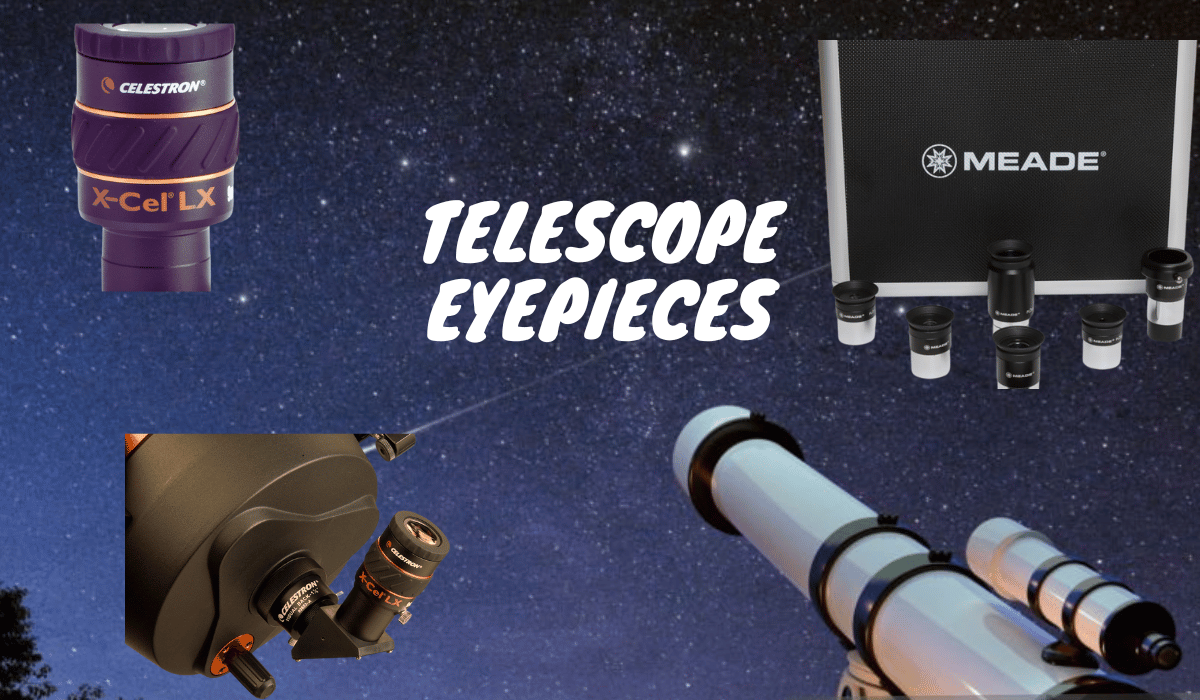The Celestron X-Cel LX Series offers the best telescope eyepiece for clarity and comfort. These eyepieces provide wide fields of view and high-quality optics.
Choosing the best telescope eyepiece can dramatically improve your stargazing experience. Quality eyepieces offer enhanced image sharpness, brighter views, and comfortable eye relief, ensuring an immersive observation session. The Celestron X-Cel LX series stands out in the market with its fully multi-coated lenses, providing excellent color correction and contrast.
This particular line caters to astronomers who seek both high-end performance and value for money, enabling clear, magnified views of celestial bodies. Enthusiasts and seasoned stargazers often consider this series as a go-to upgrade for their telescopic adventures. Whether for planetary observation or deep-sky viewing, a premium eyepiece like the X-Cel LX can make all the difference in your astronomical endeavors.

The Cosmic Quest: Choosing Your Telescope Eyepiece
The Cosmic Quest: Choosing Your Telescope Eyepiece begins with a simple truth. To unlock the vastness of space, the best telescope eyepiece is as critical as the telescope itself. The eyepiece is the final bridge between the cosmos and your eyes. It magnifies and sharpens the image crafted by your telescope’s optics. Picking the right one can turn a speckled sky into a detailed cosmic wonderland.
Tools Of The Stargazer: Importance Of A Quality Eyepiece
Think of an eyepiece as a magnifying glass for stars. It focuses the light from your telescope into your eye. A quality eyepiece can mean the difference between a fuzzy star and a sharp galaxy.
- It lets you zoom in on objects like the Moon, Saturn’s rings, or distant galaxies.
- Reduces optical distortions found in less advanced models.
- Provides comfortable eye relief for long nights of stargazing.
- Ensures a bright, wide field of view to take in more of the sky.
Choosing wisely will equip you for an extraordinary stargazing experience.
Making The Match: Telescope And Eyepiece Compatibility
Not all eyepieces fit all telescopes. Magnification is the key to determining the best telescope eyepiece. You’ll want to make sure they align perfectly for an optimal view. We will consider the focal length of both the telescope and the eyepiece to determine the magnification with the help of this formula: Magnification of Telescope= Telescope Focal Length (mm) / Eyepiece Focal Length (mm)
| Telescope Type | Eyepiece Focal Length | Resulting Magnification |
|---|---|---|
| Refractor | Short | High |
| Reflector | Medium | Medium |
| Catadioptric | Long | Low |
It’s about finding the right combo. Your telescope’s focal length paired with the eyepiece’s focal length gives you the magnification power. A high focal length eyepiece with a high focal length telescope means seeing farther but narrower. The lower the numbers, the wider and brighter you see but with less zoom.
Determine your telescope’s “focal ratio” — its focal length divided by the diameter of its lens or mirror. This number helps pick eyepieces that deliver crisp and full images.
Test different eyepieces to discover which gives the best view. Remember, the eye is unique, and personal preference matters.

Credit: www.amazon.com
Zooming In: Types Of Telescope Eyepieces
Choosing the best telescope eyepiece can be a game-changer in your stargazing adventures. It’s like picking the best lens for your camera; it defines how far and clear you will see the wonders of the universe. So, let’s dive into the world of eyepieces and discover how they can enhance your cosmic journeys.
Eye On The Sky: Fixed Vs Zoom Eyepieces
Your telescope eyepiece is your portal to the stars. But should you go fixed or zoom?
| Fixed Eyepieces | Zoom Eyepieces |
|---|---|
| Offer a single magnification level. | Allows you to switch magnifications smoothly. |
| Sharper images with higher contrast. | More versatile with a range of views. |
| May require multiple eyepieces for different views. | One eyepiece can replace several fixed ones. |
Fixed eyepieces cater to observers who want consistent quality, while zoom eyepieces are great for flexibility and convenience.
From Plössl To Orthoscopic: Diverse Eyepiece Designs
- Plössl Eyepieces: Balanced performance with a medium field of view.
- Orthoscopic Eyepieces: Sharp and less distortion for planetary viewing.
- Wide-Angle Eyepieces: Vast views of the sky, perfect for nebulae and galaxies.
- Barlow Lenses: They double or triple the magnification of your eyepieces.
Each design has its strengths. Whether it’s a crisp, clear view of Jupiter’s storms or the sprawling glow of the Milky Way, the right eyepiece awaits.
Seeing Stars: Top Features Of Stellar Eyepieces
Peering up into the night sky, anyone with a love for astronomy knows that the telescope eyepiece is a portal to the stars. Yet not all eyepieces are created equal. Discovering the best telescope eyepiece means looking out for key features that elevate your stargazing experience from ordinary to extraordinary. Let’s unlock the secrets of the universe with some stellar eyepiece features.
Wide-field Views: Exploring Eyepiece Field Of View
The field of view (FOV) of an eyepiece dictates how much of the night sky you can see at once. A wider FOV allows for more immersive observations, letting you take in the grandeur of the Milky Way or follow a comet as it blazes across the sky. Here’s why a wide-field view stands out:
- Expansive Sky Scanning: This covers more sky areas, so you can spot more stars and deep sky objects.
- Easy Tracking: Helps in following the movement of celestial objects seamlessly.
- Immersive Experience: Offers a feeling of being surrounded by the cosmos.
Crystal Clarity: The Role Of Lens Coatings And Optics
High-quality optics are crucial for sharp, bright star views. The right lens coatings and glass materials transform good eyepieces into great ones. Coatings improve light transmission, resulting in images that are brighter and free from glare. Here’s how quality optics make a difference:
| Coating Type | Benefits |
|---|---|
| Anti-reflective Coatings | Reduces loss of light and enhances contrast. |
| Fully Multi-Coated Lenses | Maximum light transmission for bright, clear images. |
Precise lens construction minimizes aberrations and focuses the light. Well-designed eyepieces can truly give you a window to the wonders of the universe.

Credit: www.amazon.com
Beyond Magnification: Understanding Focal Length And Eye Relief
Exploring the stars goes beyond just power. The best telescope eyepiece enhances the cosmos not only with magnification but also through smart design. Understanding focal length and eye relief is essential. They shape your stargazing experience, comfort, and ultimately, the quality of your observations.
Balancing Power: How Focal Length Affects Your View
Best Telescope eyepiece plays a vital role in viewing detail. Shorter focal lengths provide higher magnification, making celestial objects appear larger. However, longer focal lengths offer a wider field of view. This is perfect for gazing at star clusters or tracking satellites.
- Short Focal Length: Greater magnification, but a narrower view.
- Long Focal Length: Broader scene, lower magnification.
Choose wisely based on what you enjoy observing most.
Comfort Counts: Eye Relief For Eyeglass Wearers
Eye relief is the distance from the eyepiece where the whole field of view is visible. Long eye relief is a friend to eyeglass wearers, allowing them to keep their glasses on while observing.
| Eye Relief | User Experience |
|---|---|
| Short Eye Relief | May cause discomfort for glasses users |
| Long Eye Relief | Ideal for a comfortable view with glasses |
Forego the frustration with an eyepiece that accommodates your needs.
Gear Up: Maintaining And Caring For Eyepieces
Your telescope’s eye to the universe is only as clear as the eyepiece you peer through. Proper maintenance and care can mean the difference between a blurry view and a spectacular one. Let’s dive into keeping these vital pieces of your stargazing gear in top condition.
Cleaning Rituals: Keeping Lenses Spotless
A clean eyepiece is essential for clear viewing. Dust, fingerprints, and condensation are common nuisances. Follow these steps to keep lenses spotless:
- Use a blower to remove dust without touching the lens.
- Choose lens-friendly cleaning solutions specifically designed for optics.
- Apply the cleaning solution to a soft, lint-free cloth.
- Gently wipe the lens in a circular motion, from the center outward.
- Avoid excessive pressure, which can damage the coatings.
Secure Storage: Protecting Eyepieces From The Elements
Correct storage safeguards your eyepieces from harm’s way. Adhere to these guidelines to protect from the elements:
- Store eyepieces in a cool, dry place.
- Keep them in padded cases or bags designed for optical equipment.
| Storage Tip | Reason | Action |
|---|---|---|
| Use silica gel packets | To absorb moisture | Place in case |
| Avoid direct sunlight | Prevents lens damage | Store in shade |
| Cap lenses | Keep dust off | Use lens caps |
Remember, these eye-level companions require regular upkeep for optimal performance. Treat them well, and your eyepieces will offer you windows to the cosmos for years to come.
Industry Stars: Best Telescope Eyepieces Reviewed
The night sky is full of wonders, from distant galaxies to sparkling stars. An outstanding telescope eyepiece can transform your stargazing adventures, bringing the cosmos right before your eyes in stunning detail. Let’s discover which eyepieces are outshining the competition.
Amateur Astronomer Favorites: Eyepiece Reviews
Eager skywatchers, prepare for a cosmic treat! We’ve scoured the skies and found the top eyepieces that promise clear views without breaking the bank.
- Celestron Omni Series: With its wide field and sharp images, it’s a crowd-pleaser.
- Orion Sirius Plossl: Consistent quality and value make for happy astronomers.
- Meade Series 4000: A versatile collection for various magnifications and views.
Key Features to consider:
- Focal Length
- Eye Relief
- Field of View
Each eyepiece delivers a unique stargazing experience. It’s vital to choose one that suits your telescope and viewing preferences.
Pros’ Picks: What The Experts Recommend
What do the stargazing masters use?
| Eyepiece | Pros’ Thoughts |
|---|---|
| Tele Vue Ethos | They praise its expansive field of view and unparalleled clarity. |
| Explore Scientific 82° | Experts adore its wide-angle views and excellent optics. |
| Zeiss ZAO II | This eyepiece is revered for its high contrast and sharpness. |
Expert Advice: Match the eyepiece to your observing style. Planetary viewing or deep-space exploring?
*Different targets demand different specs.
*Invest in quality eyepieces for breathtaking astronomical journeys.

Credit: www.westernslopenow.com
Frequently Asked Questions On Best Telescope Eyepiece
What Defines A Quality Telescope Eyepiece?
A quality telescope eyepiece is defined by its lens design, field of view, and eye relief. It should provide sharp, clear images and be comfortable for prolonged observations.
How To Choose The Right Eyepiece Magnification?
To choose the right eyepiece magnification, consider your telescope’s aperture and the intended celestial target. A higher magnification is not always better as it can reduce image brightness and sharpness.
Are Expensive Eyepieces Worth The Investment?
Expensive eyepieces often offer superior optical quality, wider fields of view, and better eye relief. They can be worth the investment if they enhance your viewing experience and are used frequently.
Can Eyepieces Improve My Telescope’s Performance?
Yes, eyepieces can improve your telescope’s performance. A quality eyepiece can provide sharper images, more contrast, and a better overall observing experience.
Conclusion
Selecting the perfect eyepiece can transform your stargazing adventures, offering clarity and magnification that brings the cosmos to your doorstep. Keep in mind your telescope’s specs and personal viewing preferences for the best match. Exploring the night sky becomes truly breathtaking with the right eyepiece in your astronomical toolkit.
Clear skies and happy observing!
